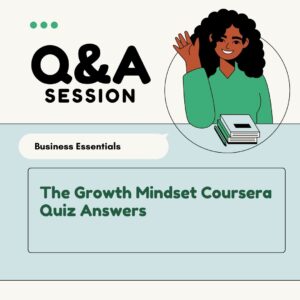All Weeks Market Research and Consumer Behavior Coursera Quiz Answers
Table of Contents
Market Research and Consumer Behavior Week 01 Quiz Answers
Quiz 1: Graded Quiz
Q1. Which of the following is NOT an ‘Internal’ factor which can influence the behavior of consumers?
- Life-Cycle
- Lifestyle
- Family
- Age
Q2. Consumer behavior refers to the __________ and behavioral processes involved when individuals or groups search, select, purchase, use, evaluate or dispose of products, services, ideas or experiences to satisfy their expected needs and desires.
- Psychological
- Philanthropical
- Physiological
- Philosophical
- Peripheral
Q3. Under rational approaches to consumer decision-making, utility is maximized with respect to which type of constraint?
- Time Constraint
- Health Constraint
- Speed Constraint
- Budget Constraint
Q4. Which are the two distinct components of the psychological phase under the ‘Consumers’ Attitudes Perspective’?
- Proactive and Reactive
- Affective and Formative
- Emotive and Cognitive
- Cognitive and Affective
- Primitive and Introspective
Q5. Which of the following is not part of Maslow’s Theory of ‘Hierarchy of Needs’?
- Safety Needs
- Social Needs
- Physiological Needs
- Development Needs
Q6. Which of the following appeals is a component of the ‘Motivational’ approaches towards ‘Consumers’ Thought Processes?
- Hunger Appeal
- Fear Appeal
- Communal Appeal
- Prestigious Appeal
- Seductive Appeal
Q7. Which of the following functions is a key element of ‘Prospect Theory’?
- Decision Profile
- Risk Profile
- Utility Profile
- Demand Profile
- Supply Profile
Q8. Under ‘Prospect Theory’, when the value of the product to be purchased is judged relative to a reference point, it is called __________.
- Combative pricing
- Rational pricing
- Odd-even pricing
- Peak-load pricing
- Reference pricing
Q9. Consumers usually have a tendency to favor stability in their purchase decisions instead of change. This is called __________.
- Status Quo Bias
- Selection Bias
- Sample Bias
- Estimation Bias
Q10. When consumers make purchases in a category that does not require high involvement, but where the frequency of transactions are higher, consumers are getting involved in what type of buying decision behavior?
- Routine
- Limited
- Extensive
- Intensive
- Essential
Q11. Which of the following components of consumer psychology do not drive their behavioral processes?
- Motivation
- Perception
- Memory
- Adaptation
Q12. Which of the perspectives of consumer behavior involves responding to stimuli as provided by marketers?
- The Cultural Perspective
- The Behaviorist Perspective
- The Economical Perspective
- The Cognitive Perspective
Market Research and Consumer Behavior Week 2 Quiz Answers
Quiz 1: Graded Quiz
Q1. When consumers are in the ‘Need Recognition’ phase of the ‘Consumer Buying Sequence’, we refer to the concepts of Ideal State vs. Actual State. When the Ideal State is higher than the Actual State, from the perspective of marketers, it is referred to as __________.
- Emotional Recognition
- Cognitive Recognition
- Nominal Recognition
- Opportunity Recognition
- Cumulative Recognition
Q2. Usually, consumers seek information about the product they are planning to purchase from alternative sources. Which of the following information sources is NOT one of them?
- Internet Advertisements
- Display Hoardings
- Electronic Media
- Academic Library
- Family and Friends
Q3. In the ‘Post-Purchase Evaluation’ stage of the consumer’s buying sequence, Satisfaction is defined as the difference between experience and __________.
- Coordination
- Understanding
- Expectations
- Response
- Elaboration
Q4. In the ‘Elaboration Likelihood Model’ of ‘Attitudes Change’, when a product purchase requires high involvement processing, marketing communications can bring the change in attitudes through __________.
- Peripheral Cues
- Focused Cues
- Logical Strength
- Argument Strength
- Mediation
Q5. Suppose you entered a grocery store to purchase some coffee. However, when you entered the coffee aisle in the store, you realized that there were not only multiple different brands that offered the type of coffee you liked in different price ranges, package sizes and flavors, but also there were plenty of alternatives for coffee which you would like to try out, like tea and infusions. Under these circumstances, which kind of decision constraint are you facing in your purchase process?
- Unexpectedness
- Tiredness
- Information Overload
- Excitement
- Enjoyment
Q6. You are the manufacturer of an unbranded product who is planning to launch it in a market that has already some established brands. Which of the following strategies you should adopt to acquire new customers?
- Maintain both the perception and attitude of consumers.
- Maintain perception but change the attitude of consumers.
- Change perception but maintain an attitude of consumers.
- Change both the perception and attitude of consumers.
Market Research and Consumer Behavior Week 3 Quiz Answers
Quiz 1: Graded Quiz
Q1. Which of the following is a component of marketing research?
- Competition
- Pricing
- Buying Behavior
- All of the above.
- None of the above.
Q2. Which is the first step in the marketing research process?
- Analysis of data
- Data collection
- Specification of information needed
- Interpretation of results
Q3. Which of the following is the best example in which to apply causal research?
- The Andrew Jergens Company periodically conducts surveys to measure consumer’s perceptions, attitudes, and use of soap bars and related personal care products.
- One-on-one depth interviews matching respondents and interviewers by gender.
- To gain insights on why Nokia is losing market share in Asia.
- To understand how consumers evaluate the Home Depot brand compared to competing brands.
- To determine the relationship between sales promotion and advertising expenditures and sales of Mercedes.
Q4. _________ are distinguished by the fact that the researcher can randomly assign test units to experimental groups and also randomly assign treatments to experimental groups.
- Quasi-Experimental Designs
- Pre-Experimental Designs
- Between and Within Subject Designs
- True Experimental Designs
- Concurrent Designs
Q5. Which of the following research designs is NOT a type of descriptive research?
- Regression Analysis
- Observational Study
- Case Study
- Normative Analysis
- Survey Report
Q6. When marketing researchers conduct exploratory research, the purpose of the research is all of the following EXCEPT:
- Establish priorities for future research
- Generate hypothesis
- Understand the causal relationship between a dependent variable and independent variable(s)
- Eliminate impractical ideas
- Refine a problem
Q7. _________ validity measures the extent to which a causal relationship found in a study can be expected to be true in the entire population.
- Independent
- External
- Internal
- Dependent
- Construct
Market Research and Consumer Behavior Week 4 Quiz Answers
Quiz 1: Graded Quiz
Q1. A measurement scale with five response categories ranging from “strongly disagree” to “strongly agree,” which requires the respondents to indicate a degree of agreement or disagreement with each of a series of statements related to the stimulus object is called a (n) ________.
- Stapel Scale
- Likert Scale
- Opinion Rating Scale
- Semantic Differential
- Penta Scale
Q2. A ________ is a representation of the elements of the target population, which consists of a list or set of directions for identifying the target population.
- Sampling Unit
- Census Tract
- Hypothesis Testing
- Geodemographic Template
- Sampling Frame
Q3. All of the following are common mistakes committed by marketing researchers determining the wording of s in a name for a survey EXCEPT:
- Double-Barreled s
- Leading s
- Clear Instructions
- Complex Words and s
- Ambiguous Words and s
Q4. ________ occurs when the sample results lead to the non-rejection of a null hypothesis that is in fact false.
- Type III Error
- Type II Error
- Type I Error
- Power of a Test
- Type IV Error
Q5. _________ validity measures the extent to which a causal relationship found in a study can be expected to be true in the entire population.
- Internal
- Construct
- Dependent
- External
Q6. All of the following are scales of measurement for secondary data, except:
- Nominal
- Ordinal
- Longitudinal
- Interval
- Ratio
Q7. When taking psychological measurements in survey research, one category of single-item measures uses a scoring method for a limited number of items that adds up to a given number. Also, this measure is used to identify relative importance. This single-item measure is called:
- Graphical Scale
- Itemized Category Scale
- Raml-Ordered Scale
- Constant Sum Scale
All Course Quiz Answers of Marketing Strategy Specialization
Market Research and Consumer Behavior Coursera Quiz Answers
Positioning: What you need for a successful Marketing Strategy Quiz Answers
Marketing Mix Fundamentals Coursera Quiz Answers



